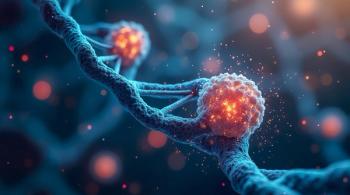
Ruxolitinib Resolves Sarcoidosis in Patient With PV
Sarcoidosis has rarely been reported with polycythemia vera (PV), an acquired myeloproliferative neoplasm characterized by mutant Janus kinase 2 (JAK2) signaling leading to erythrocyte overproduction. In a recent article in the Journal of the American Academy of Dermatology, physicians report on the case of a female patient with PV and sarcoidosis.
Sarcoidosis has rarely been reported with polycythemia vera (PV), an acquired myeloproliferative neoplasm characterized by mutant Janus kinase 2 (JAK2) signaling leading to erythrocyte overproduction. In a recent article in the Journal of the American Academy of Dermatology, physicians report on the case of a female patient with PV and sarcoidosis.
The patient experienced resolution of cutaneous sarcoidosis lesions after systemic JAK inhibitor therapy for PV, and mild improvement of pulmonary sarcoidosis.
Sarcoidosis is a chronic multisystem inflammatory disorder characterized by the formation of immune granulomas that may lead to serious, often irreversible, disability, and significant disease-associated mortality.
An African American woman in her 60s with JAK2 mutation—positive PV presented with a 12-month history of nontender, nonpruritic subcutaneous nodules in the bilateral triceps. Her PV was managed with daily aspirin and phlebotomy as needed. She denied cough, shortness of breath, ocular symptoms, joint pain, and palpitations
Physical examination found multiple subcutaneous nodules in the triceps bilaterally, and a punch biopsy found sarcoidal granulomatous dermatitis. A computed tomography (CT) of the chest showed extensive mediastinal and bilateral hilar lymphadenopathy and numerous pulmonary nodules.
Pulmonary function testing found a mild decrease in lung function, but the patient denied experiencing respiratory symptoms. Her cutaneous lesions were treated with intralesional steroid injections, which decreased the size of the targeted lesions, although multiple nodules remained. Systemic therapy was deferred.
Eight months later, the patient had headaches and elevated blood counts refractory to phlebotomy, and she was started on the JAK1/2 inhibitor ruxolitinib, 10 mg twice daily.
Five months after starting ruxolitinib, her sarcoidal skin lesions had completely resolved. In addition, her PV was responding well to therapy.
A repeat CT 7 months after beginning ruxolitinib found mild interval improvement of lung nodules and mediastinal lymphadenopathy. The clinical improvement was maintained at 9-month follow-up.
The JAK-STAT (Janus kinase—signal transducer and activator of transcription) signaling pathway plays a central role in innate and adaptive immunity as well as hematopoiesis. JAK inhibitors suppress that signaling and reduce inflammation that is mediating those symptoms, and may be a promising class of drugs for a growing list of inflammatory skin disorders such as psoriasis, atopic dermatitis, alopecia areata, and vitiligo.
The authors also noted that a recent gene expression study found that the JAK-STAT signaling pathway is significantly differentially expressed between sarcoidosis patients and healthy controls, and a severity score developed using the gene signature identified in the study correlated with sarcoidosis disease severity, suggesting that JAK-STAT signaling may be implicated in the pathogenesis of sarcoidosis.
To the authors’ knowledge, there has been 1 previous report of ruxolitinib improving necrobiosis lipoidica and a report of tofacitinib improving cutaneous sarcoidosis. They called this another “unusual case” showing the efficacy of JAK inhibitor therapy on cutaneous granulomatous disease.
Although the resolution of this patient's sarcoidosis may be secondary to successful management of her PV, a more likely explanation is the direct suppression of sarcoidosis through JAK-STAT signaling inhibition.
As with other targeted therapies for autoimmune conditions, a discordance between the responses of cutaneous and other systemic symptoms may be observed, which may explain why her pulmonary sarcoidosis was only mildly improved.
Further studies are needed, but the authors said JAK inhibitors may be a viable treatment option for sarcoidosis, especially cutaneous sarcoidosis.
Reference
Wei JJ, Kallenbach LR, Kreider M, Leung TH, MD, Rosenbach M. Resolution of cutaneous sarcoidosis after Janus kinase inhibitor therapy for concomitant polycythemia vera [published online April 5, 2019]. JAAD Case Rep. doi: 10.1016/j.jdcr.2019.02.006.
Newsletter
Stay ahead of policy, cost, and value—subscribe to AJMC for expert insights at the intersection of clinical care and health economics.














































